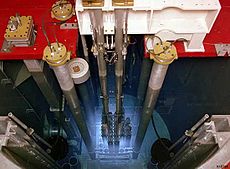TRIGA
[1] The hydrogen in the fuel is bound in the uranium zirconium hydride crystal structure with a vibrational energy of 0.14eV.
[3] [4] The TRIGA was developed to be a reactor that, in the words of Edward Teller, "is safe even in the hands of a young graduate student.
Many of these installations were prompted by US President Eisenhower's 1953 Atoms for Peace policy, which sought to extend access to nuclear physics to countries in the American sphere of influence.
Consequently, TRIGA reactors can be found in a total of 24 countries, including Austria, Bangladesh, Brazil, Congo, Colombia, England, Finland, Germany, Taiwan, Japan, South Korea, Italy, Indonesia, Malaysia, Mexico, Morocco, Philippines, Puerto Rico, Romania, Slovenia, Thailand, Turkey, and Vietnam.
TRIGA International, a joint venture between General Atomics and CERCA [fr]—then a subsidiary of AREVA of France—was established in 1996.

